Ancient Species Still Shape Our Lives
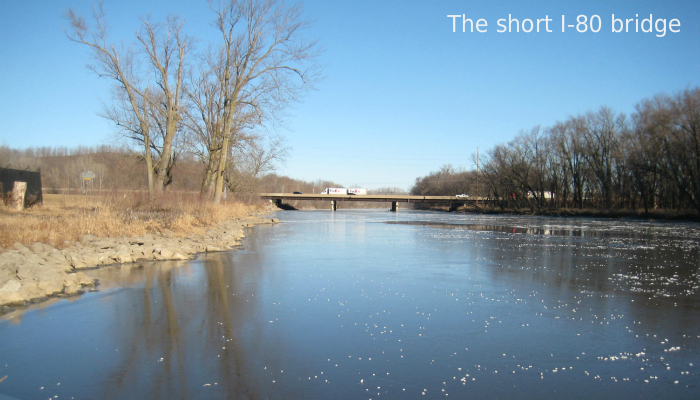
In the early pioneer era, Midwest rivers were the major means of transportation, whether canoe, flatboat, or steamboat. And so cities like Cincinnati, St. Louis, and New Orleans became important centers of population growth and commerce. And these rivers tend to run north-south, all destined for the Gulf of Mexico.
But the big population push for several centuries now has been westward, and the dominant transportation routes have shifted to being east-west, from the gold rush and wagon trains, to I-80 and the transcontinental railroads. So in order for that to happen, you need bridges across those rivers, which are expensive to build and difficult to maintain, compared to the highways and railroads they serve.
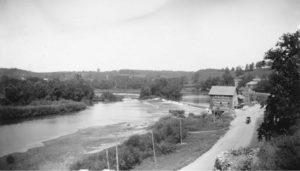
Terrell Mill and Dam, about 1895, North Dubuque Street in lower right
And so to keep the cost down, you select crossing places that only need a short bridge. Locally, here, this is located where ancient coral reefs were more durable than the surrounding rocks and this bedrock high did not get deeply covered by later glacial deposits. Later the old Iowa River cut down and created a narrow canyon through it, without much floodplain, because the river couldn’t shift around sideways. So this became the narrow place chosen for the railroad to cross the Iowa River, and with this strong link established to the east and west coast, Iowa City/Coralville evolved to become a dynamic population center. The route for I-80 was selected to run through north Iowa City for the same reason, next time you drive it note how short the bridge over the river is compared to the length of the Mehaffey Bridge six miles upstream with its wider floodplain.
This narrow bedrock canyon was also the place to build dams. Terrell Mill and Dam was located just north of today’s Park Road.
A cluster of dam-powered mills was also built further upstream, and before getting its present name, Coralville was simply called “The Mills.” That old dam has been rebuilt and refurbished several times and now has a pedestrian trail bridge atop it.
The large Coralville Reservoir Dam (not to be confused with the small dam in the City of Coralville) is placed about as far upstream as one can go in order to obtain a narrow bedrock valley to accommodate a short dam. And then the wide floodplain upstream from it can store a lot of floodwater.
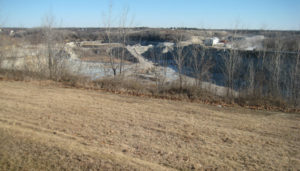
Overview of the Conklin Quarry, the river is below it in the distance
Also, in the era before poured concrete (which arrived around 1900), the limestone ledges along the river became quarries needed for building stone for the dams, roads, house foundations, factories, beer cellars, chimneys, and the most important buildings. The stone for Old Capitol was quarried just south of today’s Mehaffee Bridge and floated to the campus site on rafts. At Linder Quarry (now a little park north of Iowa City beside the river) the limestone was burned to make quicklime, the key ingredient in the mortar needed to glue all this cut rock back together. The Conklin Quarry along the river just north of I-80 still operates today.
So here in eastern Iowa, ancient species from 400 million years ago, algae, crinoids, corals, etc., have together helped lead to Iowa City/Coralville coming into existence in this place, which for many of us forms the reason we are here at this place today. Nature, yesterday, today, and tomorrow, shapes our lives. We should be supporting her.
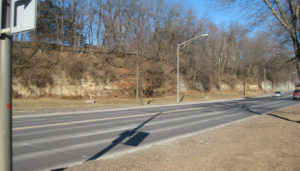
This little park beside Highway 6 is one of the dozens of little former quarries scattered along the bluffs of the Iowa River in Iowa City
The Cedar Valley Rock & Mineral Club is working to convince the Iowa Legislature to designate the crinoid as Iowa’s State Fossil, and would like your help promoting Senate Joint Resolution 2001: “A Joint Resolution recognizing the fossil crinoid as the state fossil.” For more info about crinoids, the Resolution, and how to contact your legislator, visit http://cedarvalleyrockclub.org/crinoids.html
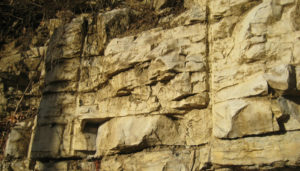
Remnants of the drill holes used for blasting powder in the old quarry above
Affirmative nature-based legislation is always a struggle in Iowa, the last piece I can remember, which had good bipartisan support, was the REAP program, April 25, 1989. Today’s red verses blue politics are so sharply divided, there is little they can agree upon. But the crinoid proposal doesn’t cost anything, so perhaps it is some small thing they can reach a truce over and start becoming functional again.


